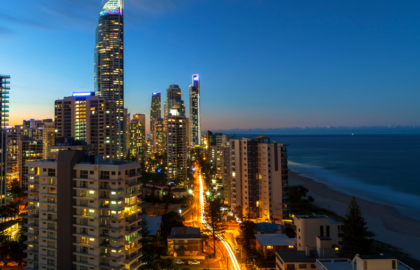
The Federal Government has granted formal approval of the Gold Coast Airport’s (GCA) 2017 Airport Master Plan
GCA Chief Operating Officer Marion Charlton said the new master plan provided an exciting look into the future of GCA.
“The approval of the 2017 master plan [ … ] is an important stepping stone in ensuring Gold Coast Airport continues to grow as an economic and aviation gateway to the south east Queensland and northern New South Wales regions,” Charlton said.
“The master plan provides a guide to the development of airport facilities, infrastructure and land uses to meet the future requirements of the aviation industry and the communities we serve for the next twenty years.
“It is particularly focused on growth in new aviation infrastructure and commercial facilities over the next 5 years including the continued expansion of the terminal and additional aircraft parking stands.
Despite the requirement of the Airports Act 1996 (Cth) that the Gold Coast Airport publish an airport master plan every five years, the new master plan came about as a response to an unstoppable growth rate. The airport has serviced 6.4 million passengers every year since their previous masterplan, approved in 2011, came into effect.
By 2037, GCA is forecast to have 16.6 million passenger movements annually (13.5 million domestic and 3.1 million international passengers).
The GCA is one of the largest employers in the region. The five-year impact of the masterplan sees an increase of the airport’s direct employment to 3,463 jobs, of which 3,108 are full-time. Through facilitation of tourism, the airport is expected to support 19,914 full-time jobs in the region.
In 20 years, the airport is expected to provide 8,995 full-time jobs. When tourism is factored in, the airport is expected to support a total of 38,012 full-time jobs in the region.
A focus of the masterplan is the continued expansion of the terminal to include enhanced passenger facilities, introduction of aerobridges and additional aircraft parking stands. This is combined with extension to existing taxiways to maintain efficient aircraft movements.
The masterplan also proposes a redevelopment of the existing internal road network to support a more efficient arrangement of passenger kerbside setdown/pick areas, public transport access and taxi and limousine lay-over areas. This will provide improved internal circulation and reduce the occasional peak hour congestion that can be experienced. An extension to the partial length parallel taxiway, between taxiway A and D, is planned during the first five-year period of the masterplan.
This will provide a full-length parallel taxiway, which will provide additional connections to accommodate demand.
“Master planning for the airport has also taken into account the future introduction of heavy and light rail facilities,” Charlton said.
“Whilst this is a medium to long term prospect, planning has occurred to ensure that future stations are highly accessible within the terminal precinct.
“The master plan also has provision for a high quality hotel development.
“In line with our previous master plans, we will continue to commit to preserving approximately 25% of the airport lease area for conservation purposes through the Cobaki Environment Precinct.
In 2016, tourism facilitated by the airport contributed an estimated $1.25 billion to the region, making the total economic impact on the gross regional product to be approximately $1.8 billion. This represents 5.7% of gross regional product.
The Economic Impact Assessment identified GCA and its associated on-airport businesses contributed an estimated $545 million to the regional economy in 2016, having grown significantly from $269 million in 2009/2010.
The master plan was prepared as per the planning framework prescribed in the Airports Act 1996 (Cth). The approved Final Master Plan will be formally published and available on the GCA website by late September this year.
The approval of the GCA Master Plan does not authorise any major development on the airport. Such developments require additional community consultation and approval by the Federal Government.
Source: theurbandeveloper.com







